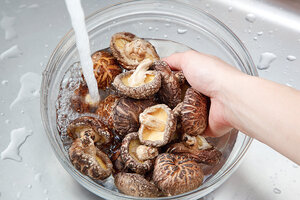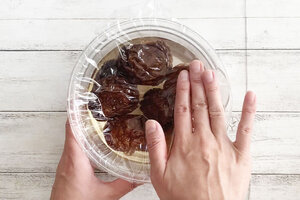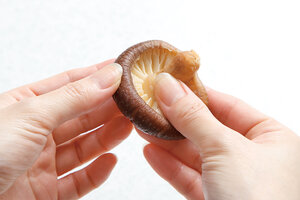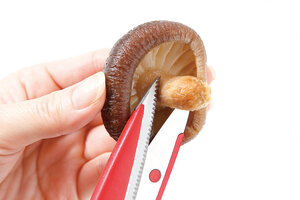- ホーム
- The most delicious way to soak dried Shiitake mushrooms.
How to Rehydrate Dried Shiitake mushrooms to achieve the best taste, texture, and Umami.
Plus, some advice for food professionals.
How to Rehydrate Dried Shiitake.
1) Clean
Please wash dried Shiitake with water and brush off any dust remaining on the Shiitake.
2) Soak in water
Please pour cold water into a container deep enough to submerge the Shiitake completely.
Cover with food wrap to touch the water's surface and prevent the Shiitake from floating above the water.
3) Slow rehydration in the fridge.
Slow rehydration at less than 10°C for 5-24 hours is required to increase the Umami Guanylate.
4) Test for readiness for use.
Because the stem is the toughest part of the Shiitake, please squeeze and check if the stem is soft and rehydrated to the core.
5) To reduce soaking time.
To reduce soaking time, take out the Shiitake one hour after you started soaking, remove the stem, soak for another hour until soft. Shiitake absorbs water from the cut surface of the center, so it can be quickly and plumply rehydrated.
Advice for Food Professionals.
The rehydrated water becomes a broth/"Dashi," which can be used in many different ways to improve the flavor and Umami taste of most foods.
Please experiment using this Shiitake Dashi in your cooking.
Unlike Chinese dried Shiitake mushrooms are grown in greenhouses using sawdust and chemicals, we grow our Shiitake on natural sweet sap oak (Sawtooth oak) logs in the forest.
Our Shiitake is completely exposed to nature where there is no cover on the top or around the Shiitake.
The growers use a 1,000-year-old Japanese approach to grow sustainable Sawtooth oak logs recognized in Japan as producing the best-tasting and textured Shiitake.
This cultivation method makes the Dashi broth very tasty, so there is no need to dispose of the first batch of broth, squeeze the Shiitake, or wash them with potato starch as you do with Chinese Shiitake.
Rehydrating at a lower temperature will produce the most Umami taste.
The enzymes that reduce Guanylate are activated at temperatures between 10 and 40℃.
For this reason, the amount of Guanylate is maximized when the dried Shiitake is soaked in water at a low temperature of 10℃ or lower in a refrigerator overnight to produce a large amount of Guanylate.
The Umami taste is maximized when the rehydrating water temperature is close to 0℃.
To speed up the rehydration process, cut off the stem or cut the Shiitake's umbrella into appropriate sizes during the rehydration process.
You can accelerate water absorption from the cut surface.
After cool and slow rehydration, heating will further increase the Umami.
Before heating, strain the Dashi broth (soaking water) to remove any fine dust or particle.
You will get a clearer and cleaner taste.
The enzymes that increase Guanylate are also activated at temperatures between 50 and 75 degrees Celsius.
For the most efficient, increase in Guanylate, you should heat Shiitake and the soaking water by high heat to 75°C, turn off the heat, and leave for 10 minutes.
After this, Shiitake and their rehydrated water are brought to a boil to deactivate the enzyme that reduces the Guanylate in Shiitake, thereby keeping the maximum Umami flavor.
Our Forest-grown Shiitake is very flavorful, so try using a small amount as a subtle secret ingredient not to overpower the taste of your foods.
There are two types of Umami synergies known to exist.
In general, only the first type is well known.
1. Glutamate × Inosinate
(All foods) x (Meat and fish)
2. Glutamate × Guanylate
(All foods) x (Dried Shiitake)
Dried Shiitake can make your dishes, even more delicious.
For more information, see:
http://www.umamiinfo.com/richfood/
You can combine Shiitake with meat or fish to make even better, more wonderful, and delicious dishes.
Shiitake also adds the best natural Umami to Vegan dishes.
If you use too many high-quality Shiitake in the soup, the Umami flavor might become too strong and result in a bitter taste.
If that happens, reduce the amount of Shiitake Dashi and increase the amount of other Dashi.
Guanylate, an Umami component unique to dried Shiitake, gives a bitter taste if its concentration is too high.
You can simply dilute it to solve the problem.
More information about natural Umami.
https://dev.sugimoto.co/en/how-to/why-does-dried-shiitake-make-food-taste-better/

